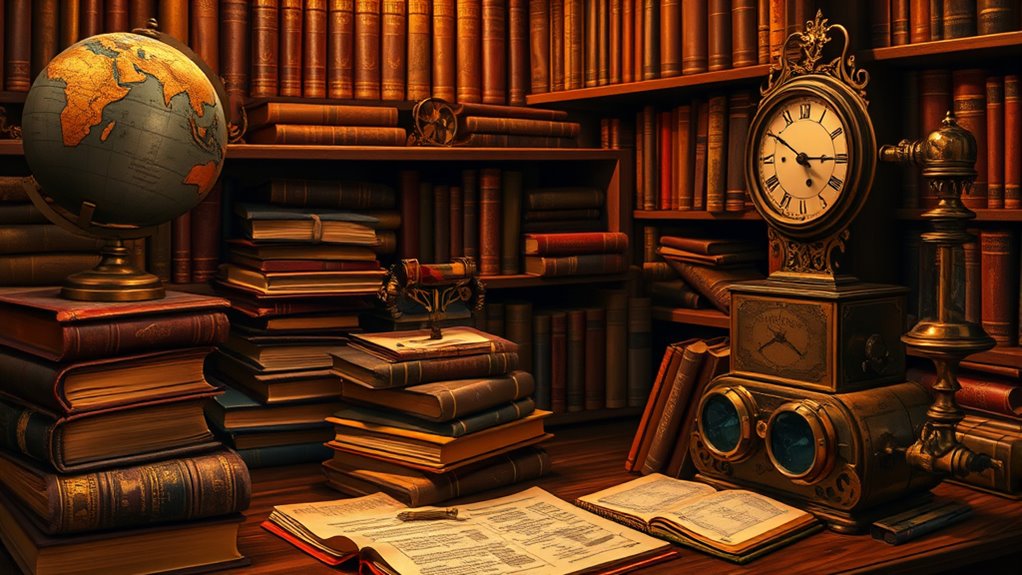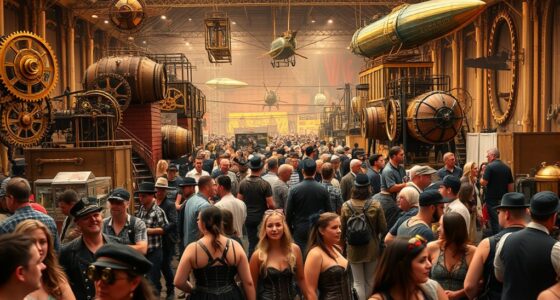Beyond Verne and Wells, steampunk draws inspiration from lesser-known Victorian works that blend science fiction with Gothic adventure. You’ll find influences from stories filled with dark laboratories, mysterious inventions, and exploration of moral ambiguity. These hidden literary roots add depth to steampunk’s aesthetic and themes, emphasizing wonder alongside danger. If you want to uncover more about these fascinating sources that shaped steampunk’s rich tapestry, there’s plenty more to explore just ahead.
Key Takeaways
- Gothic adventure literature introduced atmospheres of mystery, obsession, and supernatural elements that influence steampunk’s darker aesthetic.
- Victorian pulp and dime novels contributed vivid, imaginative worlds and technological fantasies often overlooked today.
- Early science and industrial utopian writings inspired visions of societal progress and technological optimism beyond Verne and Wells.
- Romantic-era science fiction, emphasizing individual inventors and moral dilemmas, shaped steampunk’s complex characters and themes.
- lesser-known Victorian authors like Mary Shelley and Edward Bulwer-Lytton offered narratives of innovation intertwined with danger and moral ambiguity.

Have you ever wondered what books and stories shaped the distinctive aesthetic and themes of steampunk? While Jules Verne and H.G. Wells are often credited as the pioneers of Victorian science fiction, many other literary influences quietly contributed to the genre’s unique blend of industrial innovation and Victorian sensibilities. Among these, Victorian science fiction itself played a crucial role, providing a foundation rooted in technological optimism and exploration. These stories often depicted elaborate inventions, airships, and steam-powered machinery, shaping the visual language of steampunk. But beyond these well-known authors, a lesser-celebrated yet equally influential genre emerged: Gothic adventure.
Victorian science fiction, with its fascination for discovery and the marvels of machinery, set the tone for imagining worlds where technological progress was intertwined with human ambition. Think of stories where inventors push the boundaries of possibility, or where steam-powered contraptions become symbols of both innovation and danger. Such narratives fueled the steampunk aesthetic, which celebrates elaborate gadgets, clockwork mechanisms, and retro-futuristic cities. They also fostered themes of exploration, moral ambiguity, and the impact of technology on society—core elements that continue to resonate within steampunk storytelling.
Victorian science fiction inspired steampunk with its themes of invention, innovation, and technological exploration.
Meanwhile, Gothic adventure added a darker, more mysterious layer to the genre’s evolution. Gothic stories, with their moody atmospheres, haunted settings, and elements of the supernatural or the uncanny, infused steampunk with a sense of Gothic adventure. Imagine fog-shrouded Victorian streets, secret laboratories, or abandoned factories haunted by the echoes of past experiments. These settings evoke a sense of wonder tinged with foreboding, emphasizing themes of obsession, madness, and the thin line between progress and peril. Gothic adventure also introduced characters like mad scientists, explorers, and adventurers who explored forbidden knowledge or uncovered dark secrets—archetypes that are still prevalent in steampunk narratives.
Together, Victorian science fiction and Gothic adventure shaped the aesthetic and themes of steampunk by blending the optimistic pursuit of progress with a fascination for the mysterious and the arcane. They encourage a sense of wonder and discovery, but also remind us of the potential hazards of unchecked ambition and technological hubris. An understanding of literary influences such as these reveals how the genre’s rich visual and thematic elements are rooted in a complex tapestry of Victorian-era storytelling. This duality is what makes steampunk compelling: a richly textured universe where innovation and darkness coexist. So, when you immerse yourself in steampunk stories, remember that their roots extend beyond Verne and Wells, drawing from a complex tapestry of Victorian science fiction and Gothic adventure that continues to inspire and inform the genre’s distinctive style.
Frequently Asked Questions
Which Lesser-Known Authors Significantly Influenced Early Steampunk Aesthetics?
You’ll find that lesser-known authors like William Hope Hodgson and M.P. Shiel markedly shaped early steampunk aesthetics. Their Victorian pulp stories blend Gothic revival elements with inventive machinery, creating a dark, atmospheric vibe. These writers explore themes of adventure, mystery, and technological wonder, influencing steampunk’s gritty yet fantastical style. Their works often go unnoticed but are essential to understanding the genre’s rich, layered visual and thematic roots.
How Did Non-English Literary Traditions Shape Steampunk Themes?
Imagine gears turning alongside vibrant tapestries of European folklore and Asian mythology. These traditions deeply influence steampunk themes, blending fantastical elements with Victorian innovation. You see, European folklore introduces mystical creatures and moral tales, while Asian mythology offers intricate stories of transformation and divine intervention. As you explore steampunk, you realize it’s a melting pot of global stories, enriching its aesthetic with diverse cultural mythologies that challenge the Western-centric view of technological progress.
Are There Specific Works That Directly Inspired Steampunk Technology Concepts?
You’ll find that Victorian patent records and Jules Verne’s works directly inspire steampunk technology concepts. Verne’s inventive ideas and detailed descriptions spark creativity, while patent records provide real-world technological foundations. These sources help you imagine steampunk gadgets blending Victorian aesthetics with inventive engineering. By studying these references, you see how fiction and actual inventions intertwine, shaping the imaginative and technological spirit of steampunk.
Did Historical Scientific Texts Impact Steampunk’s Portrayal of Inventions?
You might find that historical scientific texts influence steampunk’s focus on scientific authenticity and technological realism. By referencing real scientific principles, steampunk creators craft inventions that feel believable and grounded in history. This reliance on actual scientific knowledge enhances the genre’s immersive quality, making the inventions seem plausible and inspiring a sense of wonder rooted in real-world science. These texts help shape steampunk’s unique blend of fantasy and scientific credibility.
How Have Indigenous Stories Contributed to Steampunk Worldbuilding?
Did you know that over 60% of steampunk stories incorporate indigenous narratives to enrich worldbuilding? You see, these cultural storytelling elements bring authenticity and depth, blending traditional myths and legends into inventive settings. By weaving indigenous stories into steampunk, you create diverse, vibrant worlds that honor different histories and perspectives, making your universe more compelling and nuanced. This approach celebrates cultural diversity while expanding steampunk’s imaginative horizons.
Conclusion
So, next time you immerse yourself in a steampunk tale, remember it’s more than just Verne and Wells shaping the world. Hidden influences, like forgotten inventors and obscure writers, breathe life into this genre—much like the unseen gears turning behind the scenes of a fantastical machine. Keep exploring, and you’ll uncover these secret roots, reminding you that every story is part of a larger, intricate tapestry woven through time—much like Pandora’s box of endless possibilities.









